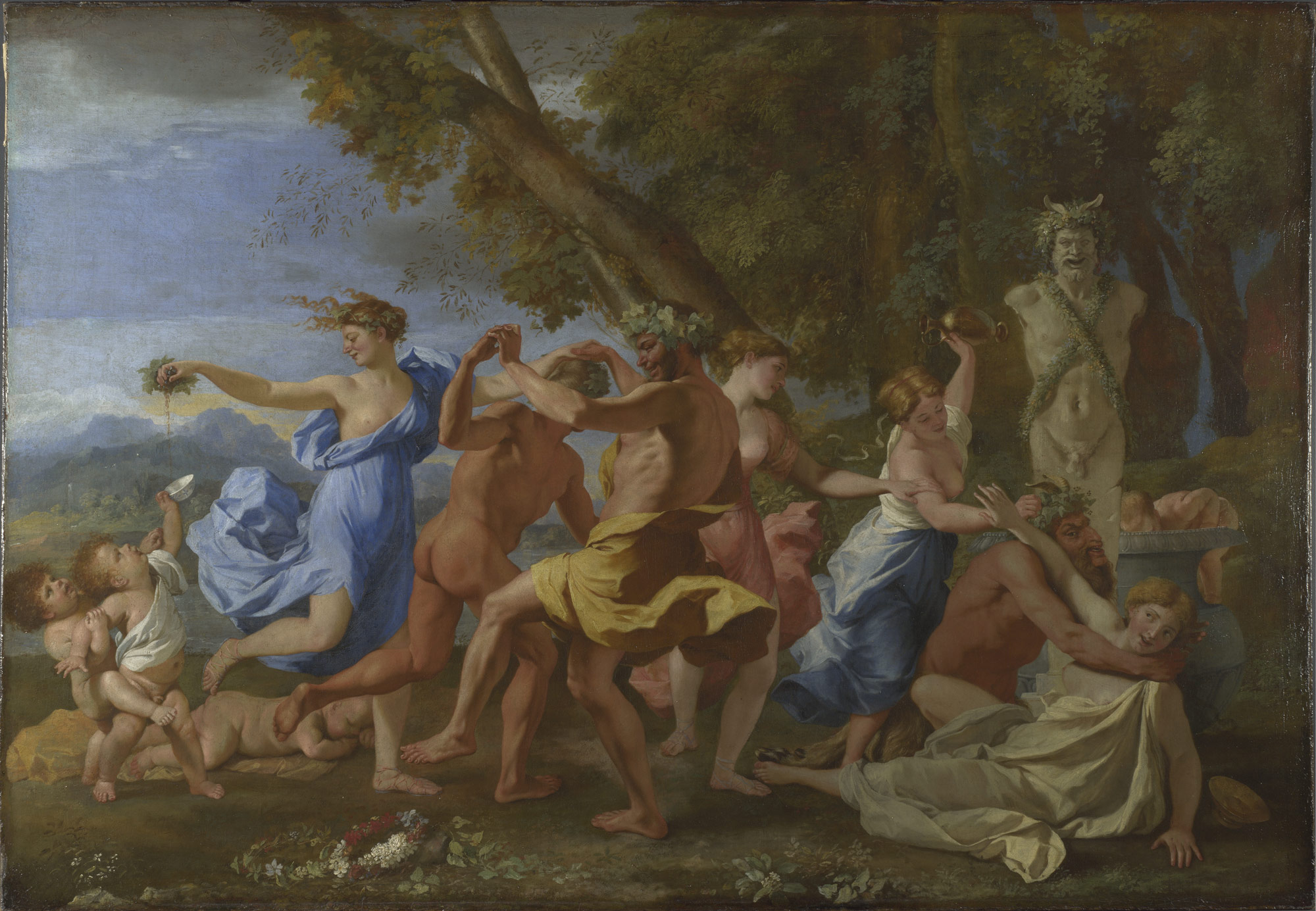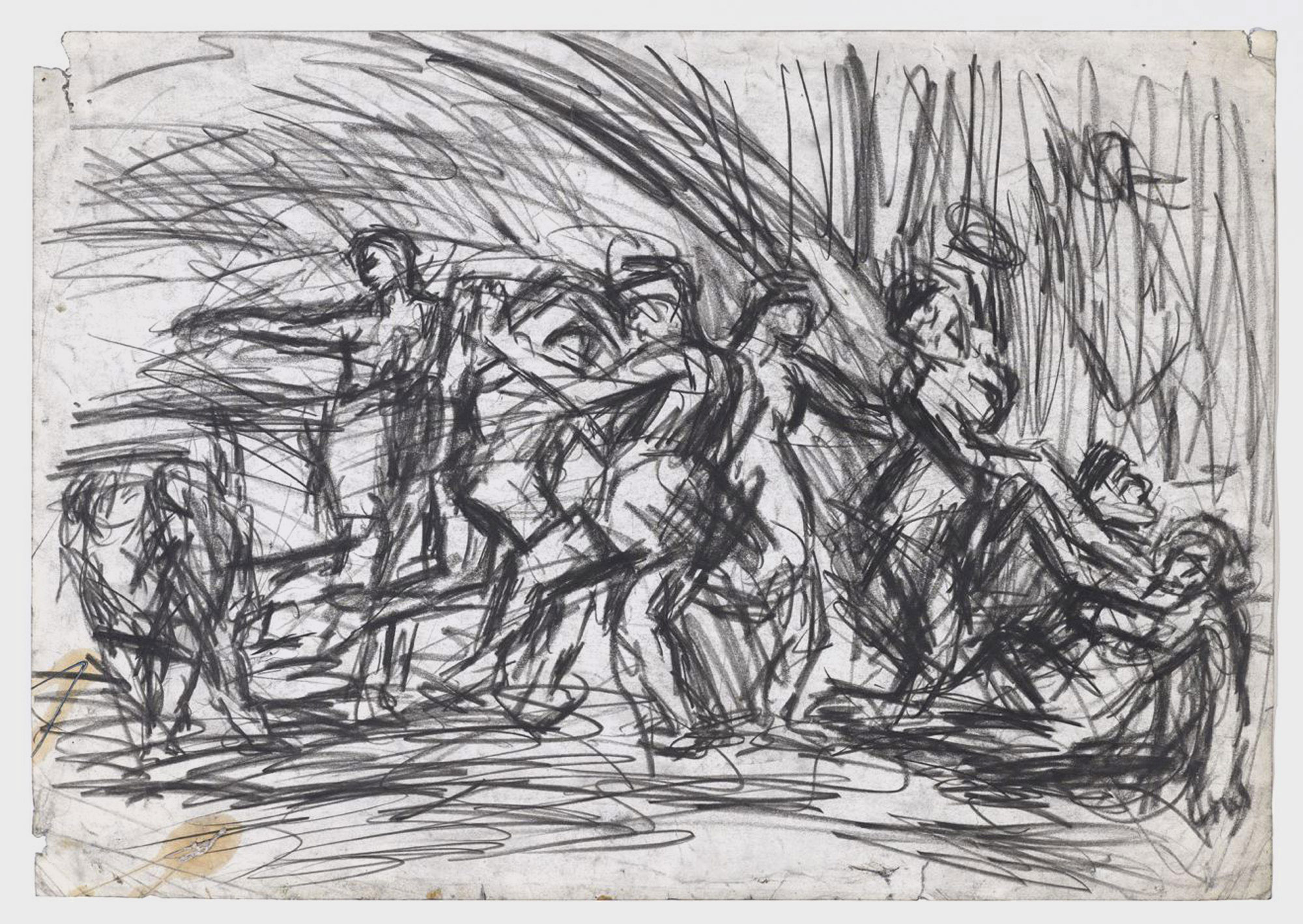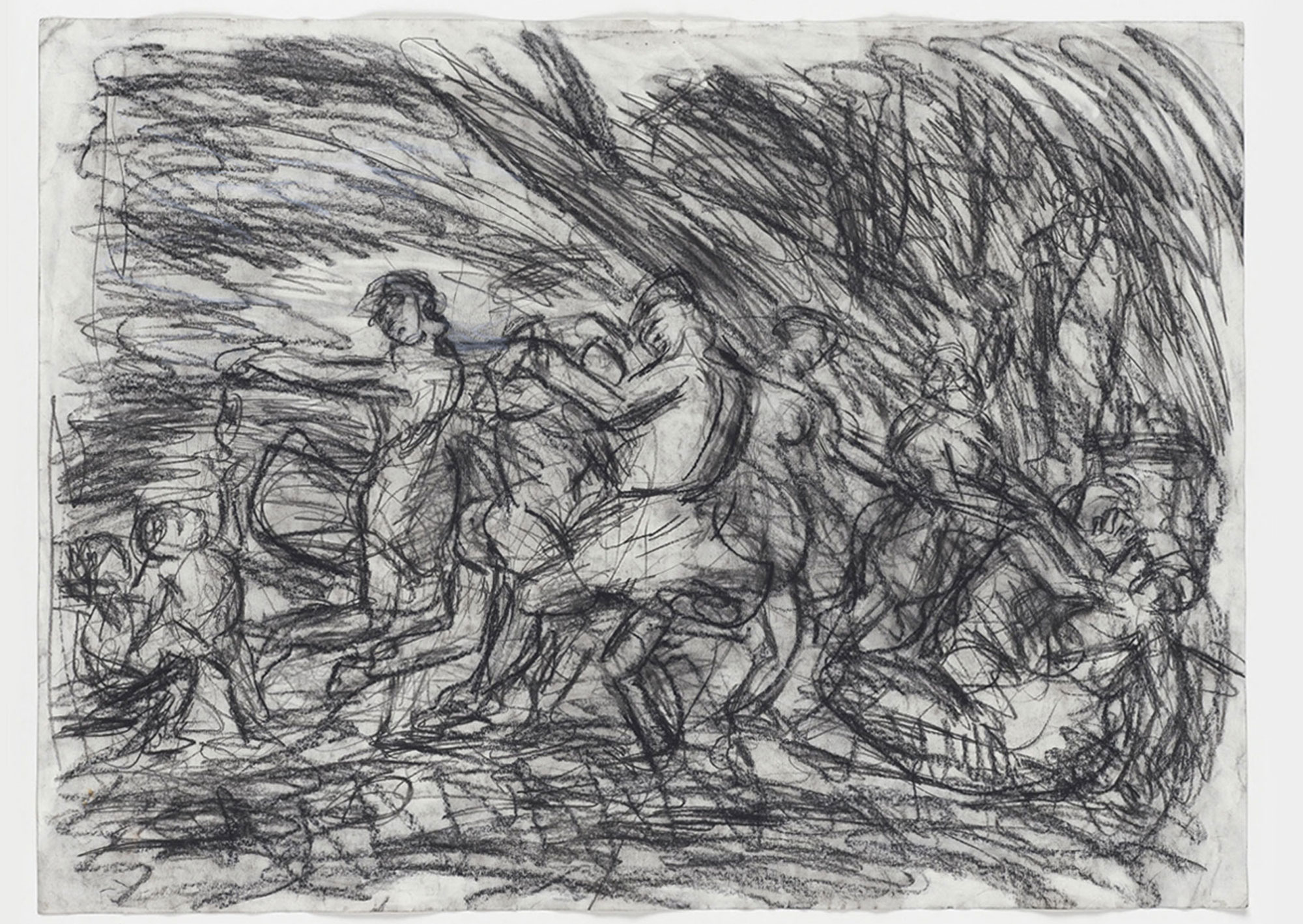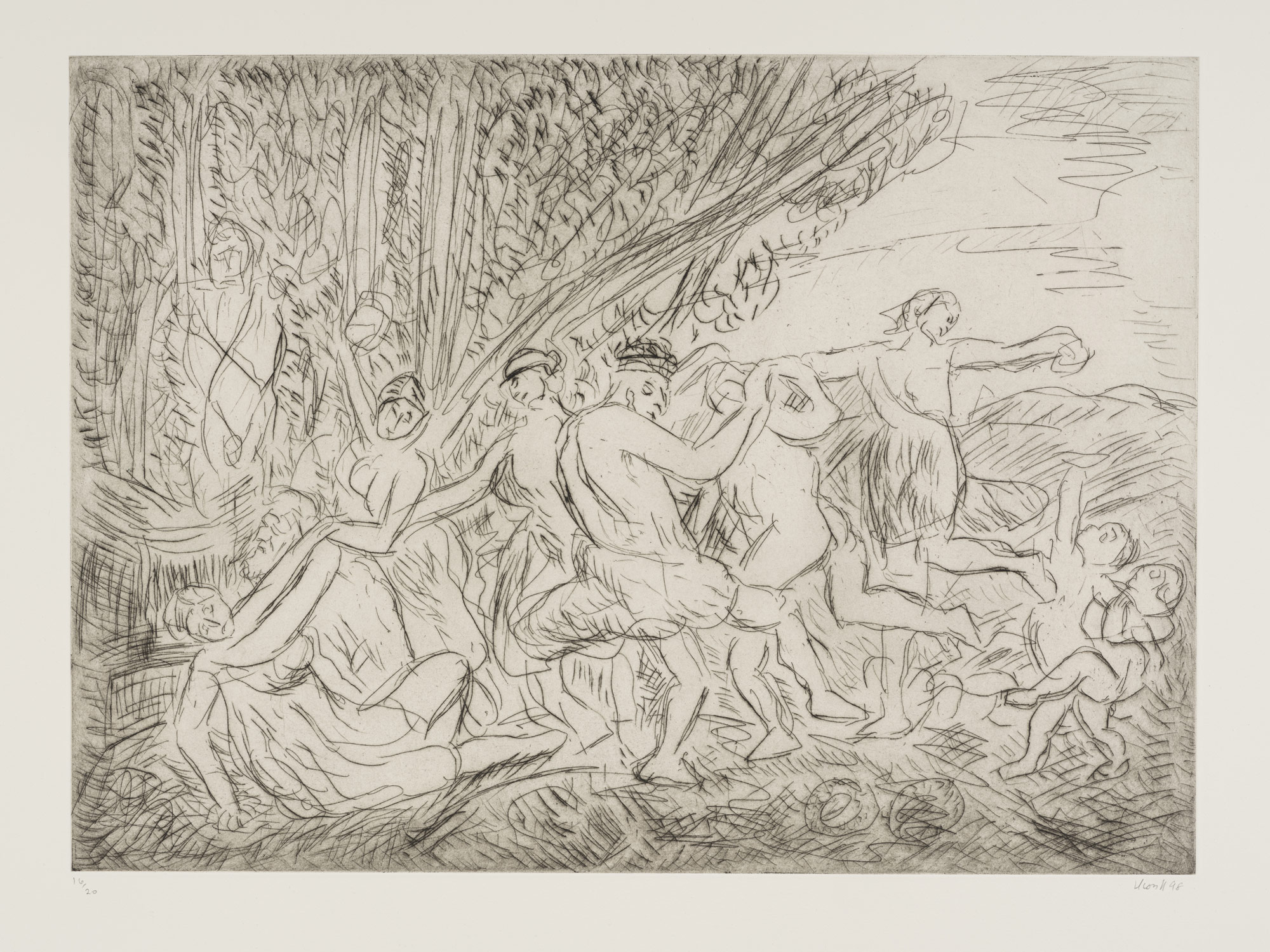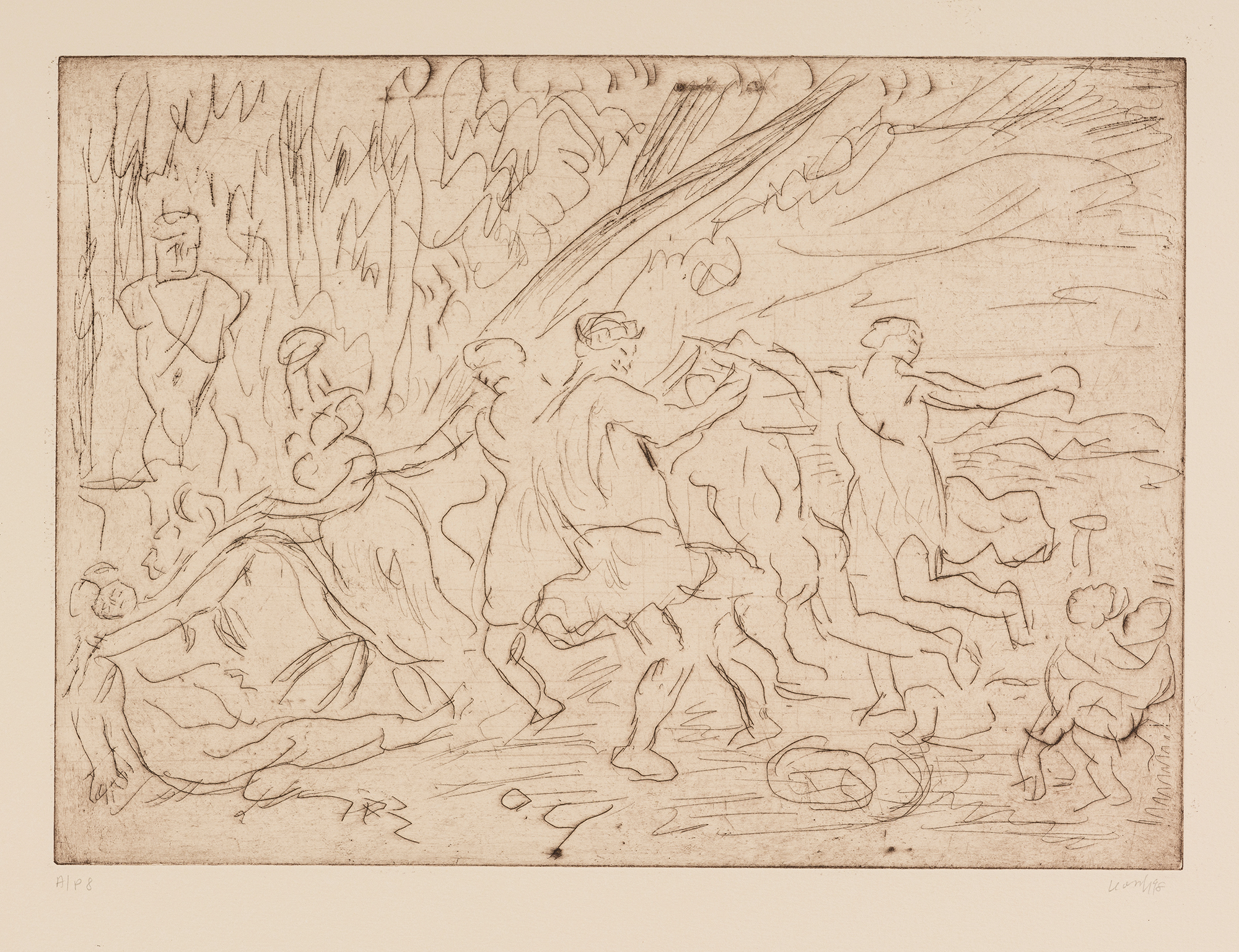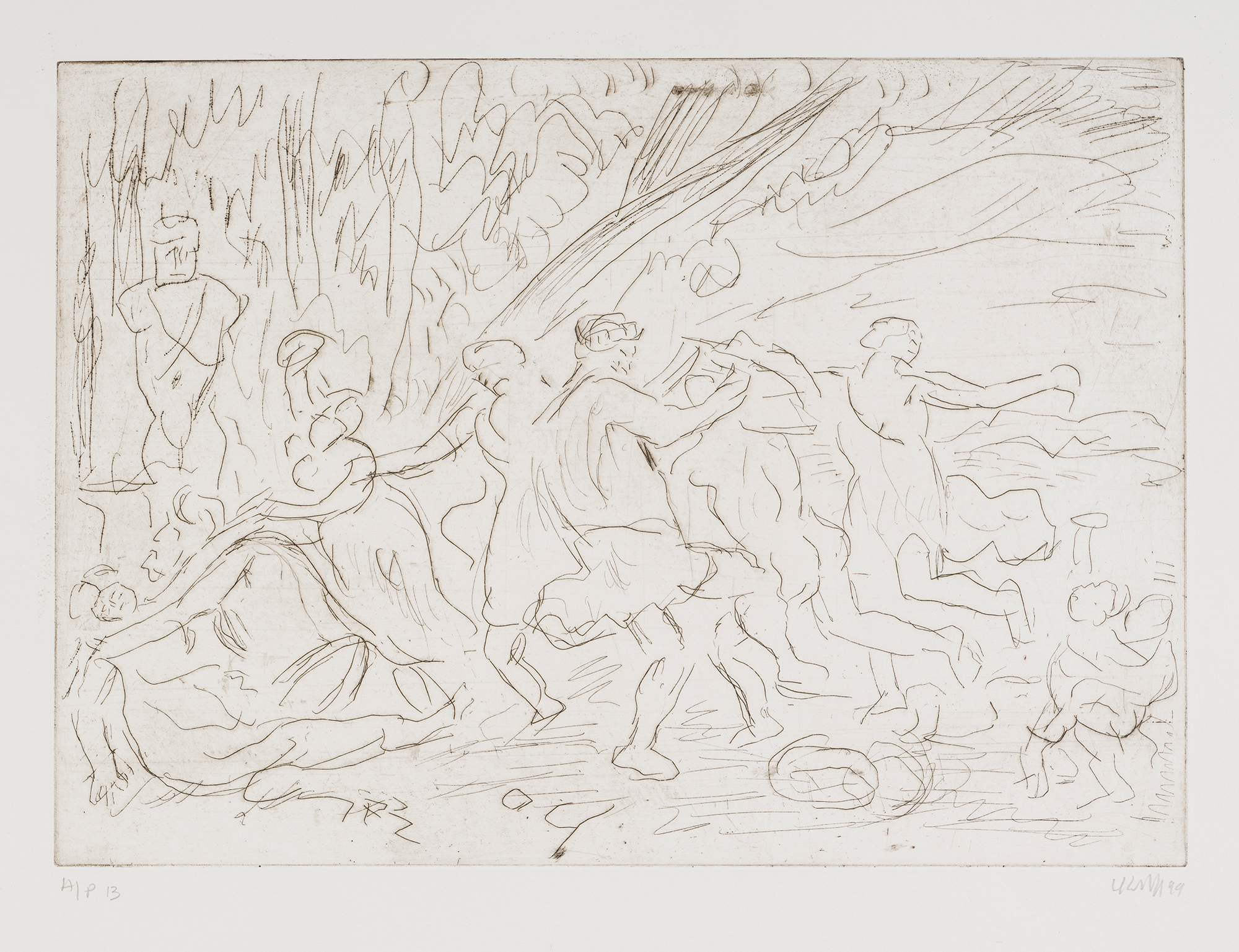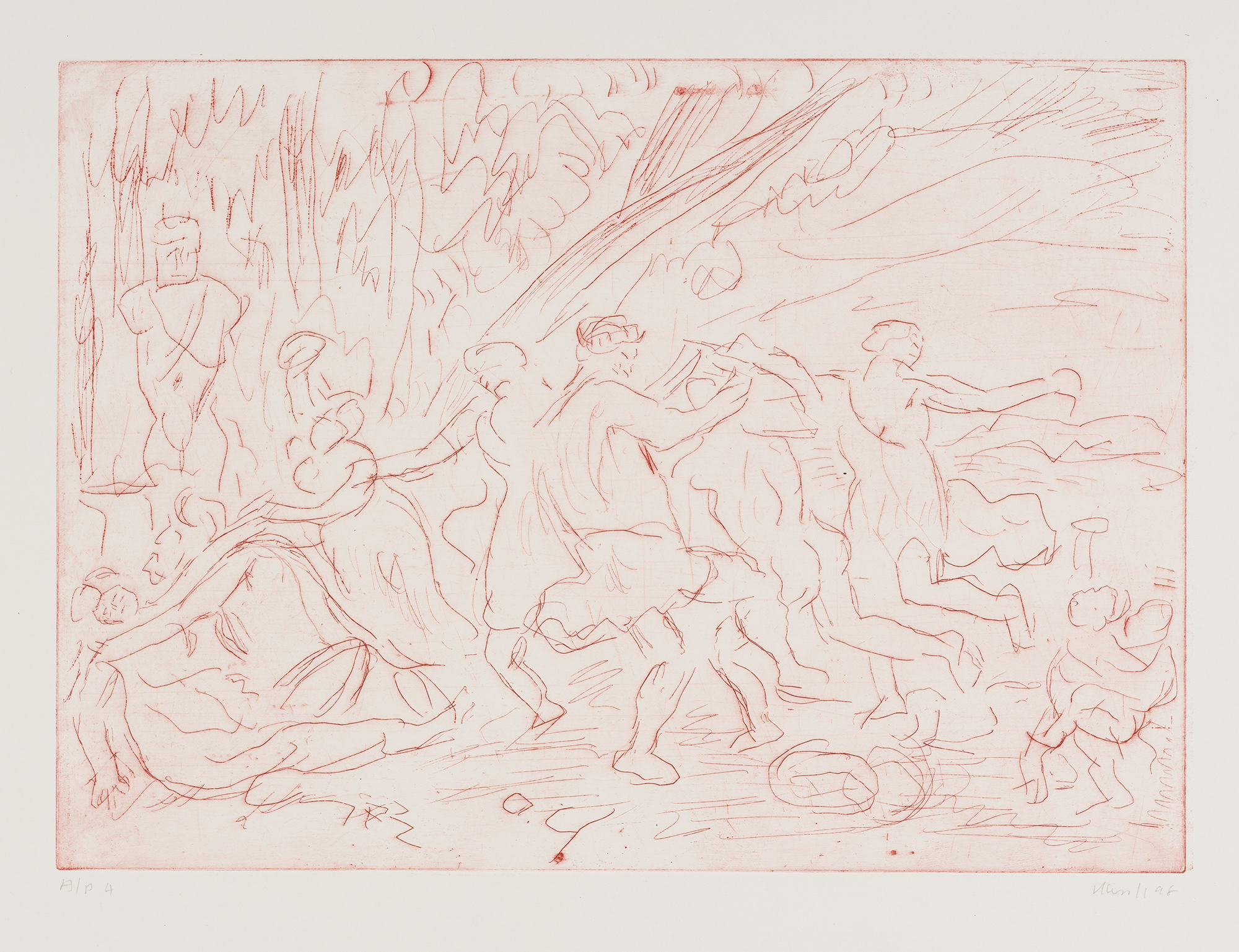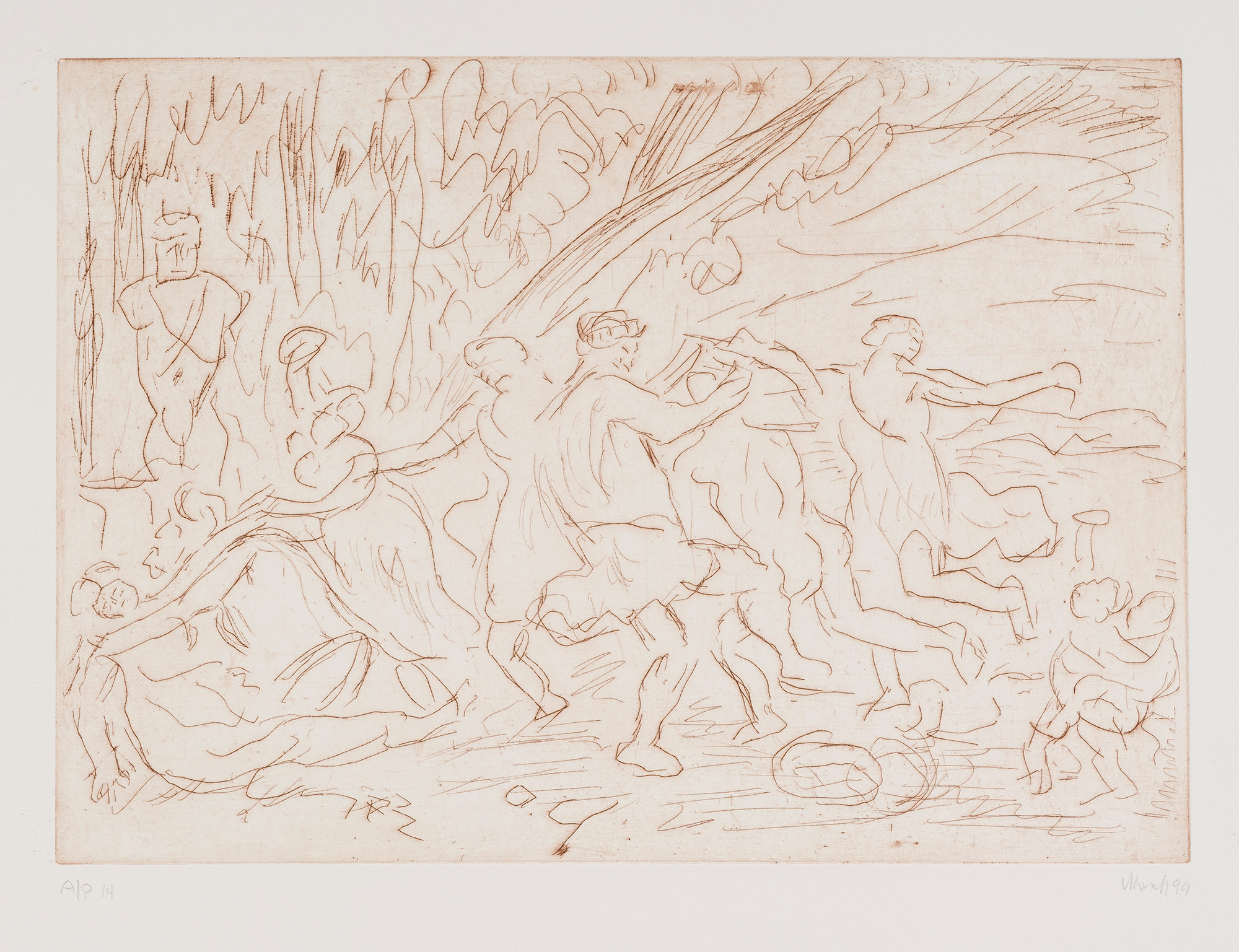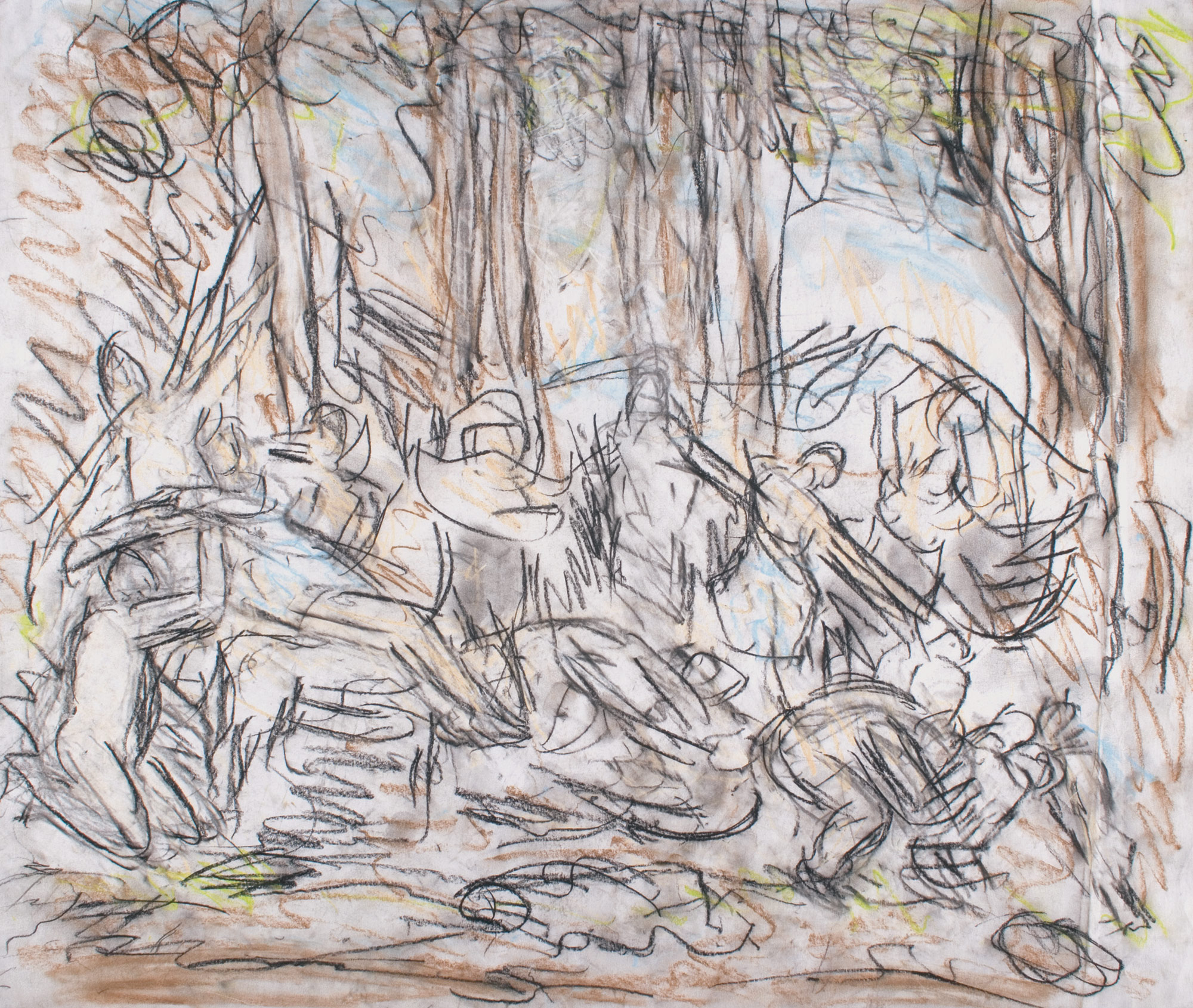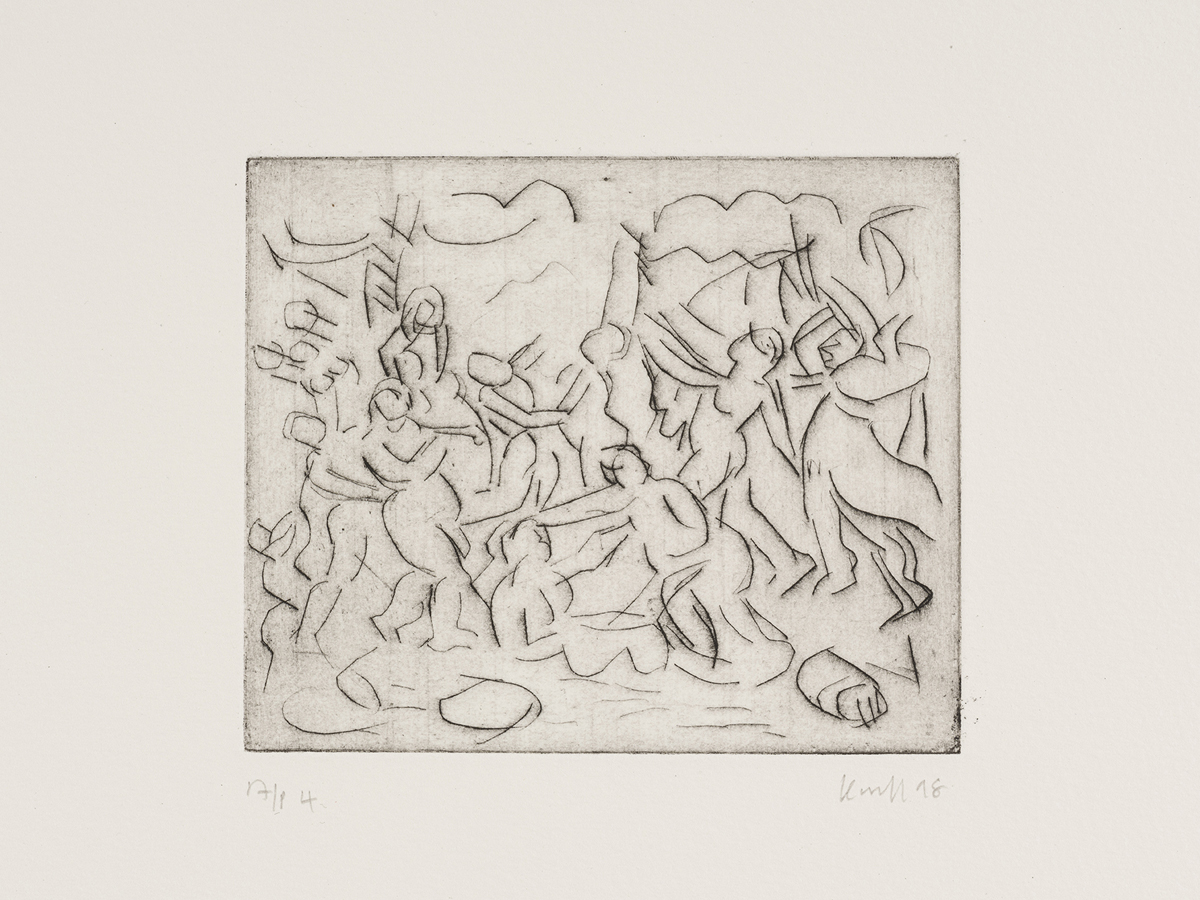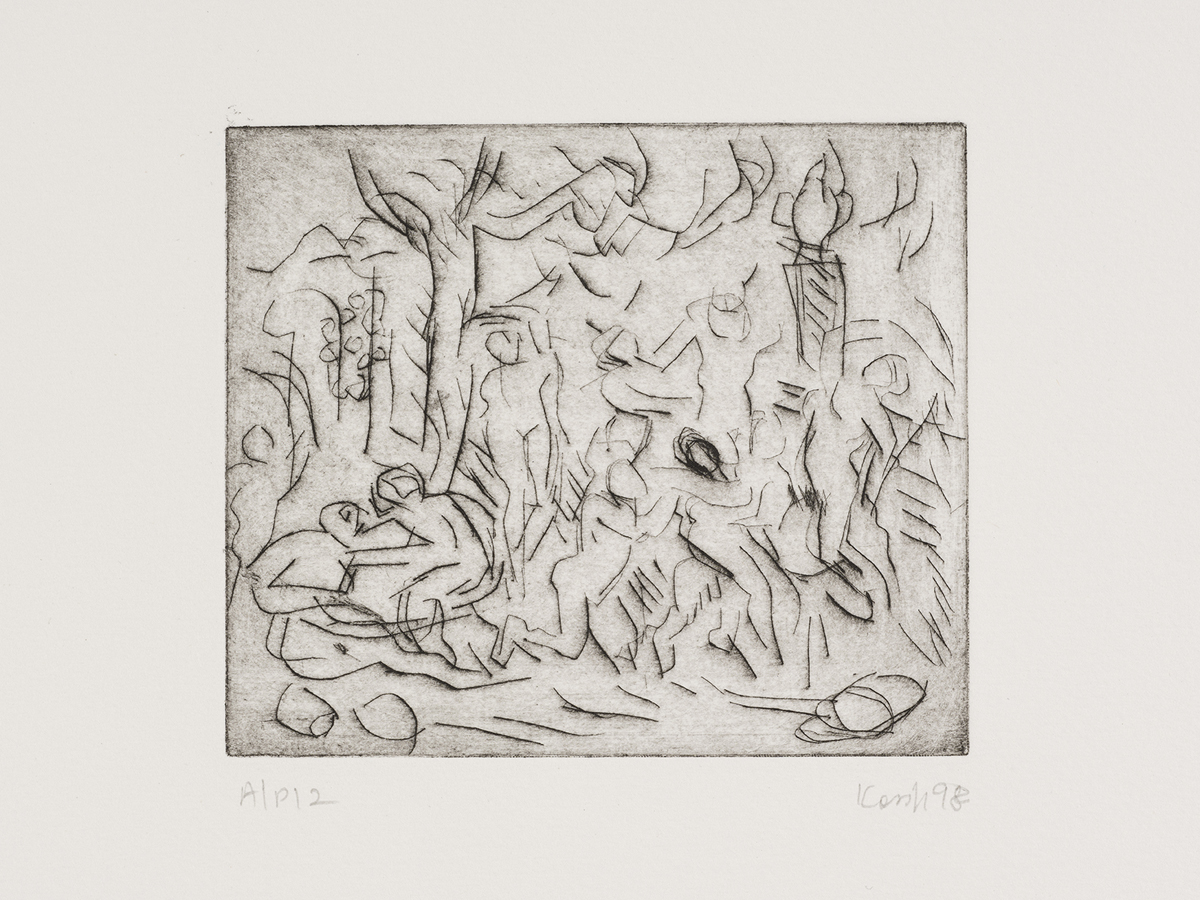
Leon Kossoff had a lifelong practice of drawing from the Old Masters, most often in the galleries of London’s National Gallery. He stated that “working from the Old Masters opens doors for you to go on with your own work,” and as such he studied the classics intently and methodically. He had a privileged pass that allowed him access to the galleries before the general public, and he often hauled sketchpads and etching plates across town and into those hallowed halls in the early predawn hours. His process encompassed hundreds of drawings, completed very quickly, made in order to achieve a visual intimacy with his subject, be it a classical painting, a model in the studio, or the landscape around him. Drawing was his foundation, a means of knowing, remembering, experiencing, and “seeing” the world.
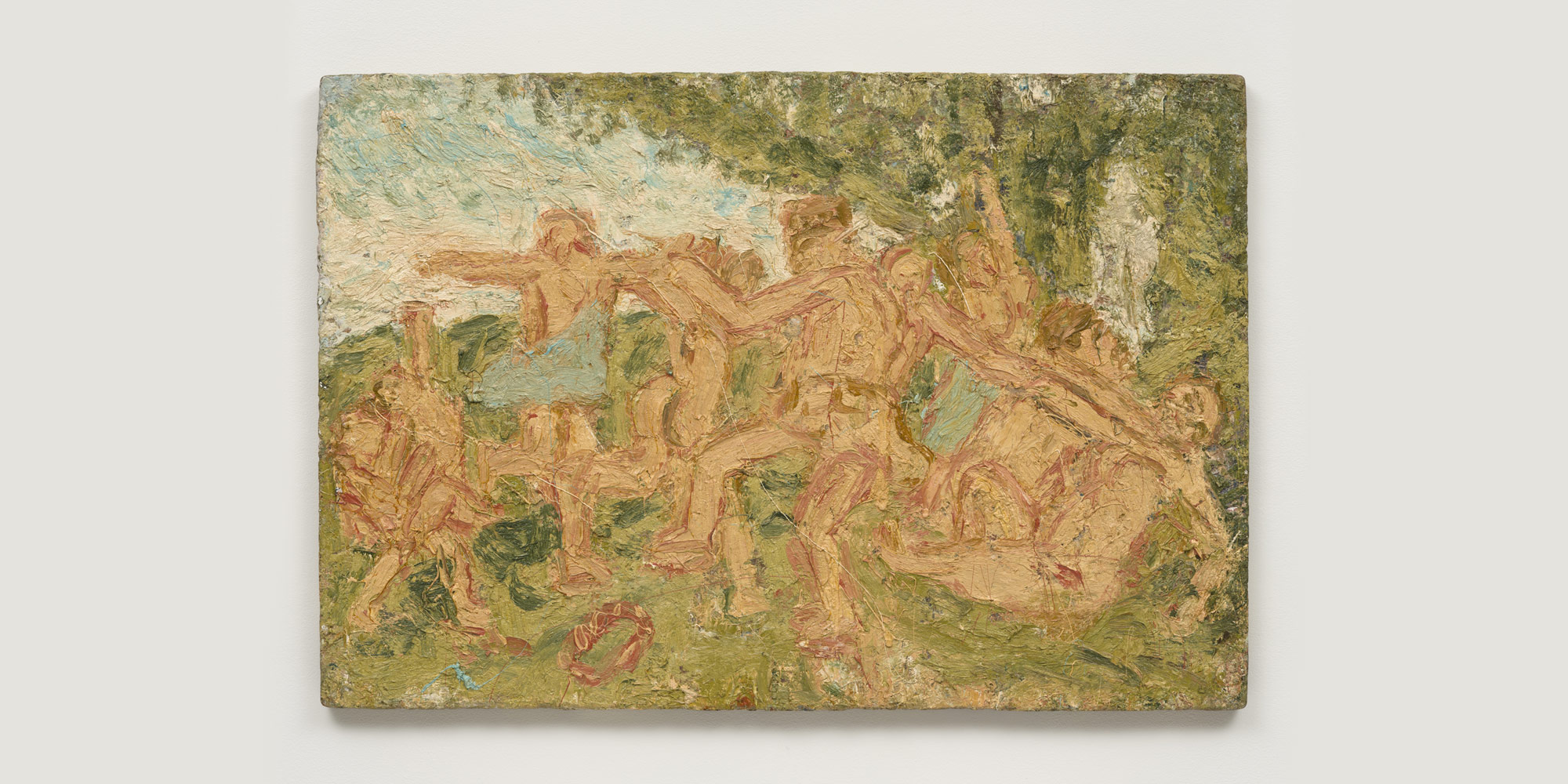

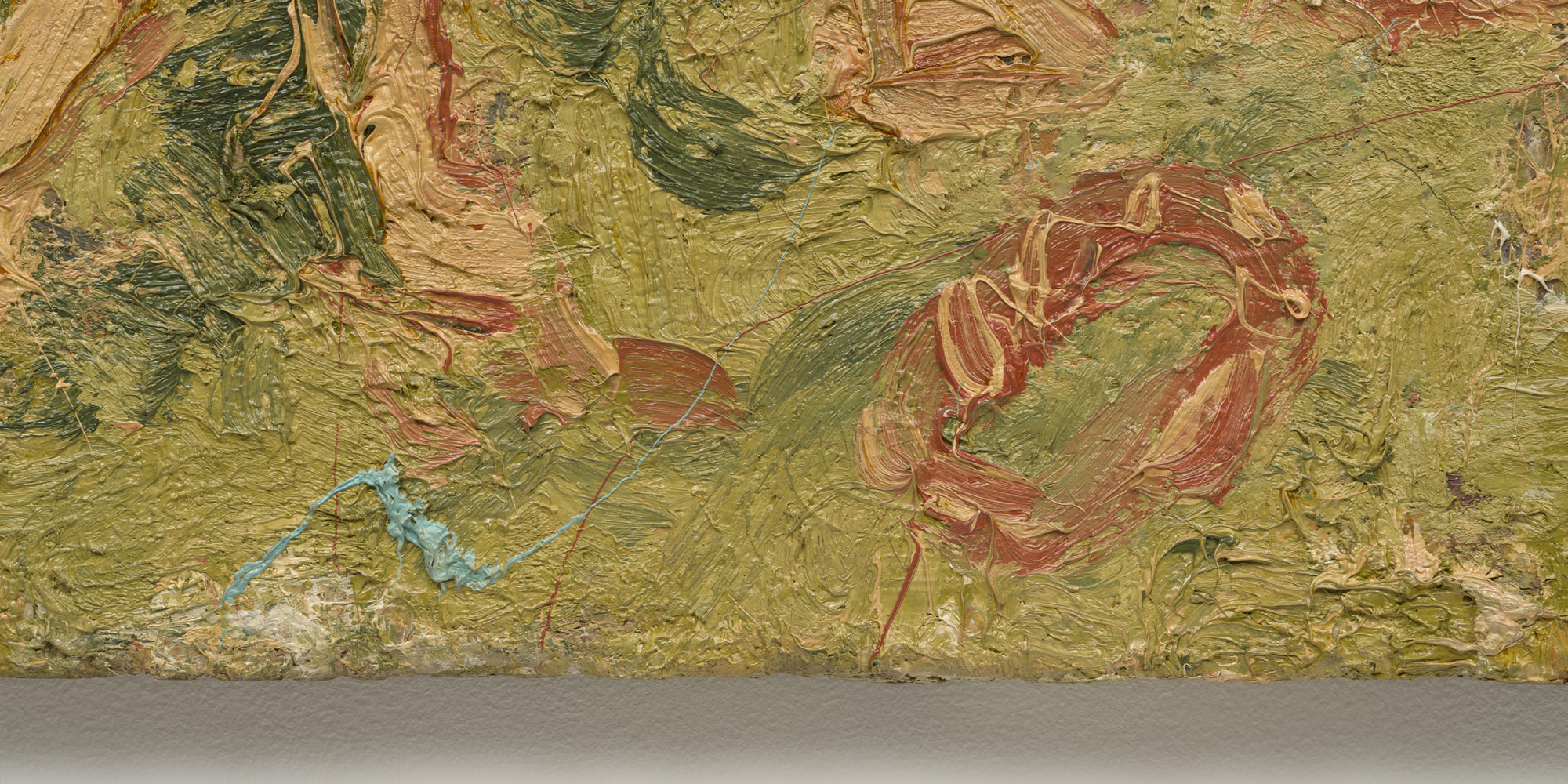
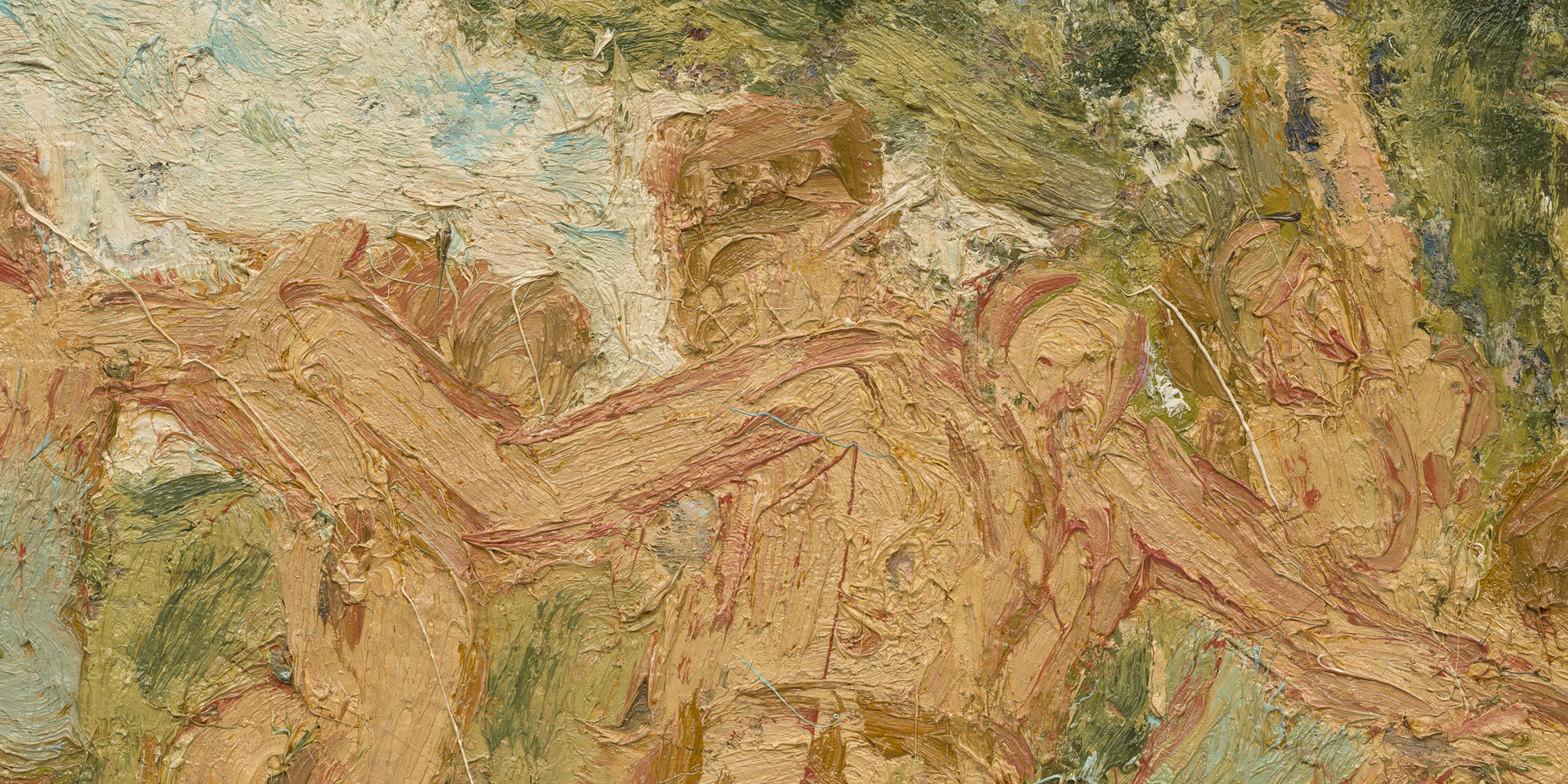
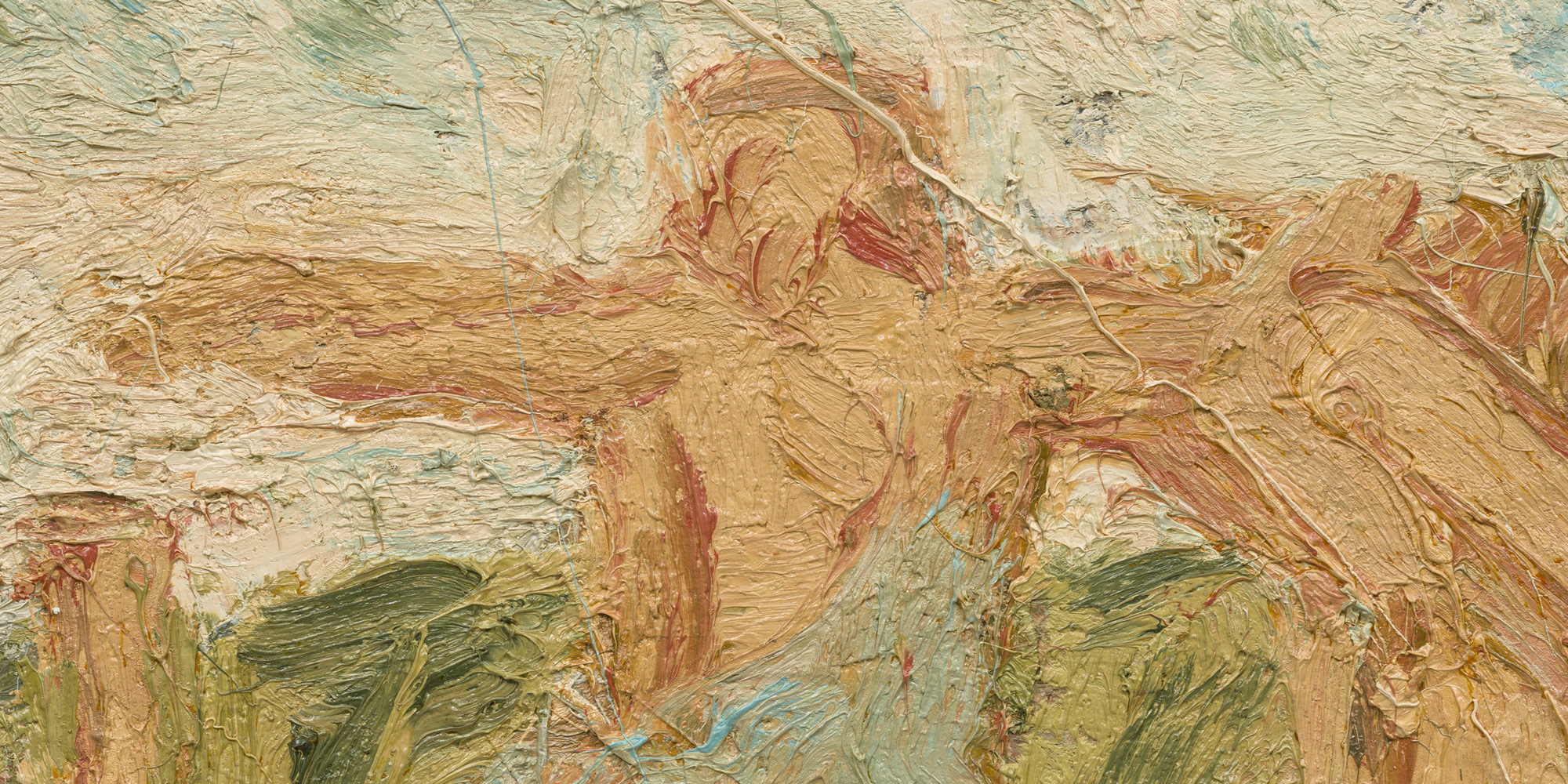
Leon Kossoff
Bacchanal before a Herm of Pan by Poussin No. 2, 1998
oil on board
39 x 57 in. (99.1 x 144.8 cm)
Inquire
In 1995, a major exhibition of the work of Nicolas Poussin took place at the Royal Academy in London, and this afforded Kossoff the opportunity to work with many paintings that had been gathered from all over the world. Energized by the astounding array of Poussin's work, Kossoff labored tirelessly on hundreds of drawings and eventually drew directly into zinc or copper etching plates while situated in front of the Poussins. Our focus in this presentation is on two series of images made during this period, The Triumph of Pan and Bacchanal Before a Herm, the latter brilliantly exemplified by the superb 1998 painting Bacchanal before a Herm of Pan by Poussin No. 2. In these works, Kossoff captures the Dionysian revelry and compositional rigor of the classical master, all channeled through his own particular style of urgent, energetic drawing.
Both germinating paintings by Poussin, A Bacchanalian Revel before a Term (c. 1634) and The Triumph of Pan (1636), are held in the National Gallery’s collection, which allowed the artist to continue their study after the close of the Royal Academy exhibition. They are related in their compositional rigor, the dynamic quality of twisting figures, the joy expressed in the scenes, and the energy of the lines themselves. They provided a thrilling experience for Kossoff, one that is captured beautifully in both his drawings and etchings. The frenzied lines characteristic of these works resolve into scenes full of vitality and pictorial rhythm, a modern distillation of Poussin’s classical passions.
Leon Kossoff
Bacchanal Before a Herm, 1998
etching, printed by Mark Balakjian
Plate: 16 1/8 x 22 3/8 in. (41 x 56.8 cm)
Sheet: 22 1/2 x 29 7/8 in. (57.2 x 75.9 cm)
Edition of 20
Inquire
Four prints from the same plate:
Leon Kossoff
Bacchanal Before a Herm II, 1998
unique artist's proof, printed by Ann Dowker
Plate: 11 3/4 x 16 1/2 in. (29.8 x 41.9 cm)
Paper: 22 1/2 x 24 1/2 in. (57.2 x 62.2 cm)
Left to right: A.P. 8, A.P. 13, A.P. 4, A.P.14
Inquire
Poussin’s orderly classicism may not at first seem like a natural fit for Kossoff, whose linework and paint application can most readily be described as ferocious. Yet the modern artist was drawn to the emotional weight of Poussin’s subjects and the rigorous balance of his compositions. Poussin’s lush rendition of Cephalus and Aurora first caught Kossoff’s eye in the 1960s, and from this transformative moment he sought out Poussin as a great inspiration. He returned again and again to Poussin’s works, as Andrea Rose writes, “searching and watching them, drawing from them in order to hone his skills and to absorb the essentials of composition and construction that makes these old paintings such supreme advisors.”
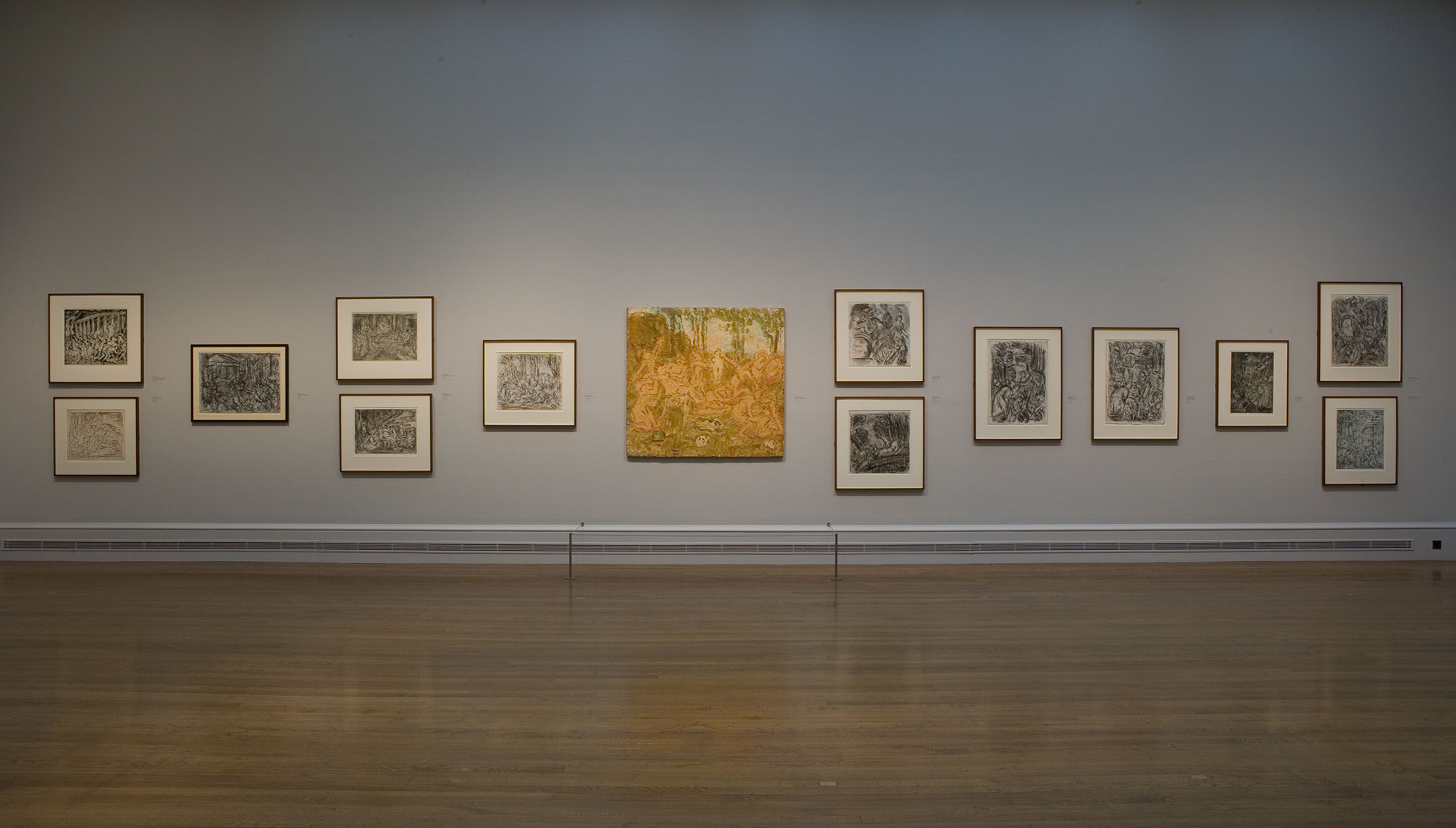
Installation view
Leon Kossoff: Drawing from Painting
National Gallery, London, 2007
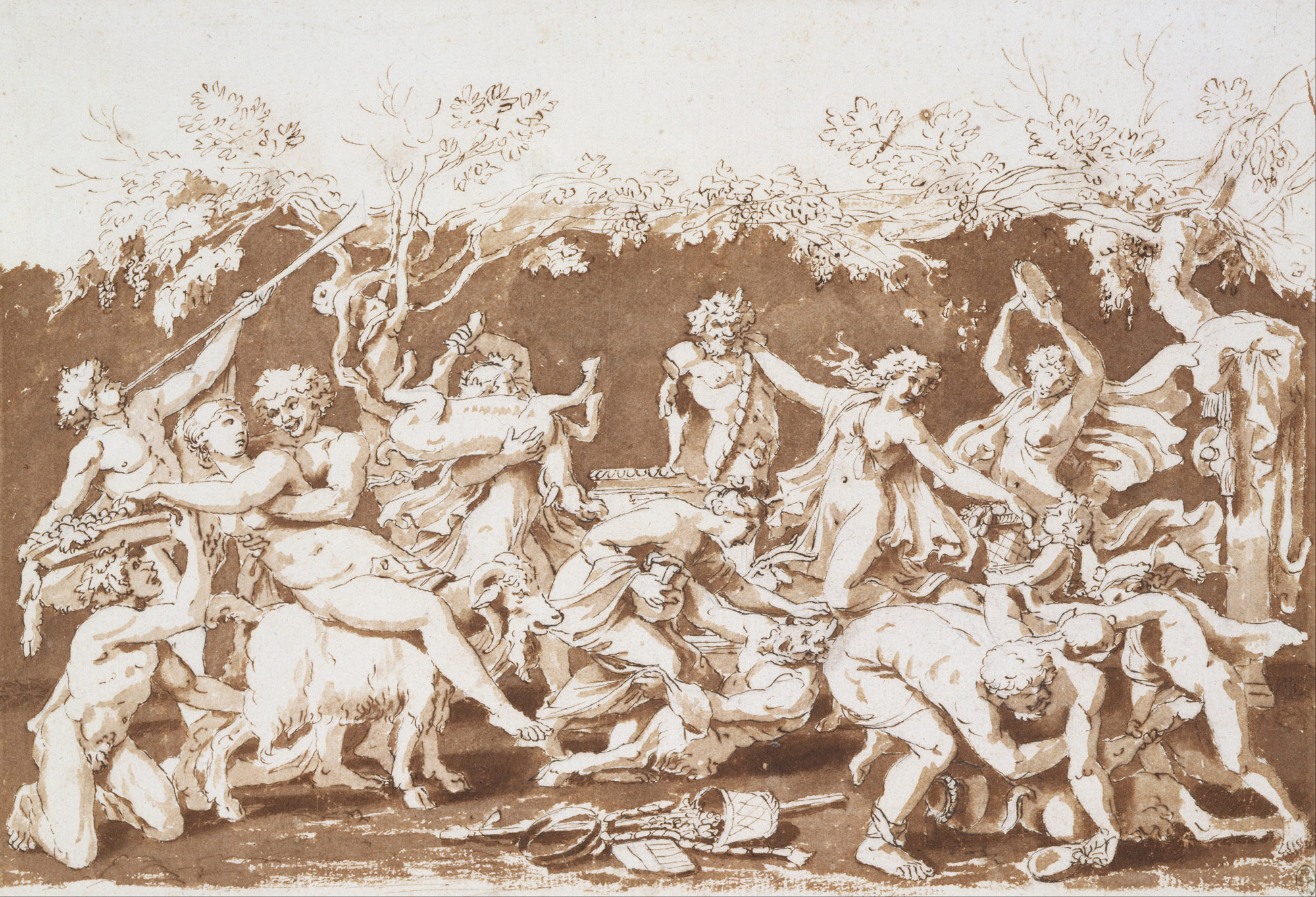
Nicolas Poussin
Triumph of Pan, c. 1635
pen and ink with wash, over black chalk and stylus on paper
9 x 13 1/4 in. (22.9 x 33.7 cm)
Royal Collection Trust, Windsor
© Her Majesty Queen Elizabeth II
Leon Kossoff
From Poussin: The Triumph of Pan, c. 1998
coloured chalks on paper
20 1/4 x 23 1/3 in. (51.2 x 59.4 cm)
framed: 31 x 33 1/2 in. (78.7 x 85.1 cm)
Private Collection
Inquire
Kossoff’s collaborations on these subjects with printmakers Ann Dowker and Mark Balakjian produced distinct, lyric prints that capture the vibrant energy and compositional solidity of Poussin with an urgency of line that is all his own. Working with the two different printers allowed exploration of divergent aspects of Kossoff’s experience with Poussin. Balakjian produced consistent results with tightly drawn, concise images, while Dowker, a fellow artist rather than a professional printmaker, retained the freshness and immediacy of Kossoff’s drawings through constant modification.
Leon Kossoff
The Triumph of Pan (From a Poussin Drawing I), 1998
unique artist's proof, printed by Ann Dowker
Plate: 4 x 4 3/4 in. (10.2 x 12.1 cm)
Paper: 15 3/4 x 14 3/8 in. (40 x 36.5 cm)
Inquire
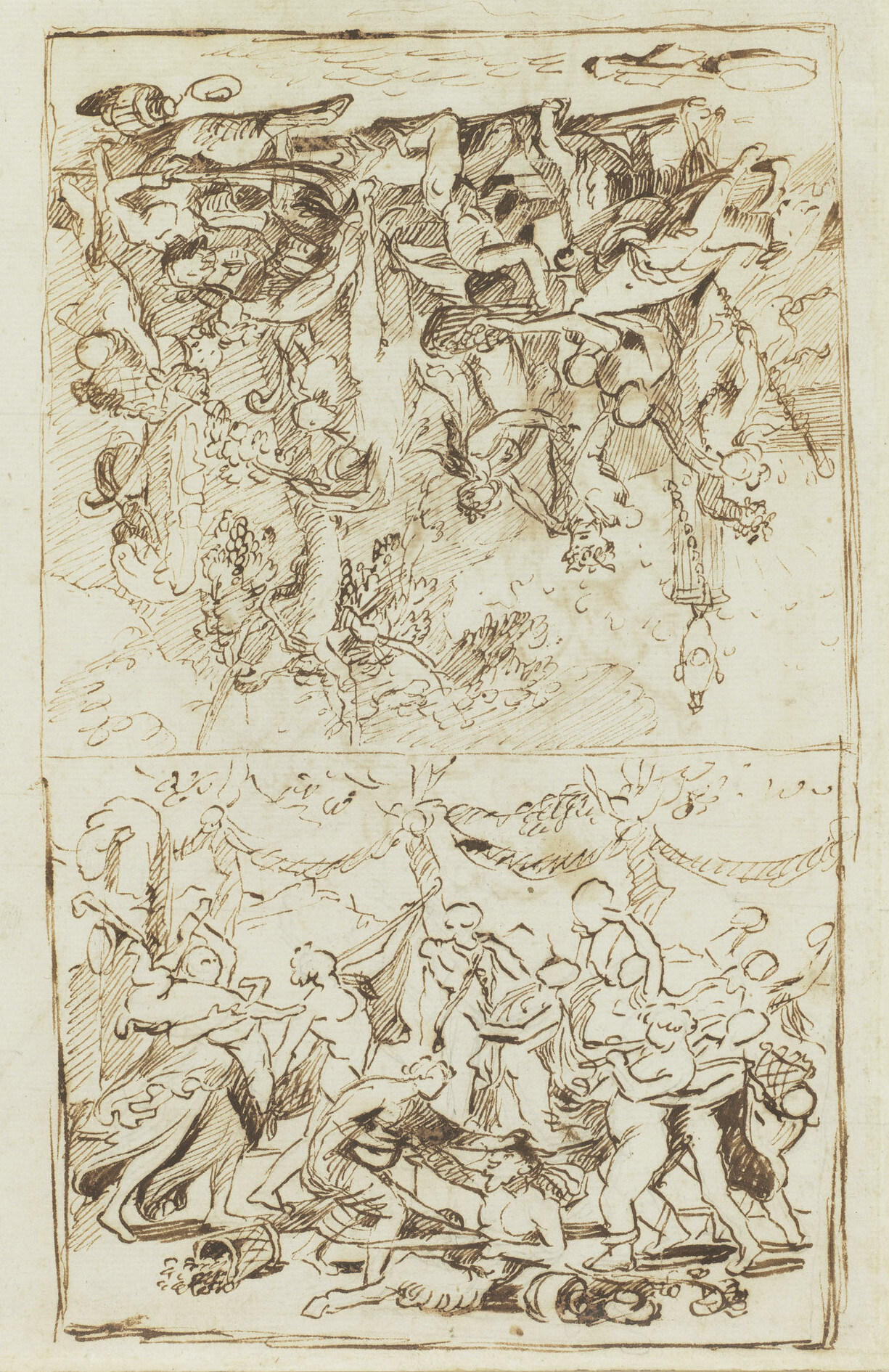
Nicolas Poussin
Preparatory study for The Triumph of Pan (Verso), c. 1635-36
pen and brown ink on paper
12 3/8 x 7 15/16 in. (31.4 x 20.2 cm)
Royal Collection Trust, Windsor
© Her Majesty Queen Elizabeth II
Leon Kossoff
The Triumph of Pan (From a Poussin Drawing II), 1998
unique artist's proof, printed by Ann Dowker
Plate: 3 7/8 x 4 9/16 in. (9.8 x 11.6 cm)
Paper: 15 7/8 x 14 3/8 in. (40.3 x 36.5 cm)
Inquire
Kossoff delighted in experimentation with Dowker, using the variation produced by different colored inks, diverse papers, and repeated ink wipings on the printing plates to produce unique artist's proofs that are more analogous to monotypes than to the repetition of traditional printmaking. These often reveal a classical quality, evident in the set of four unique proofs of Bacchanal Before a Herm II, shown near the top of this page. The feeling achieved is sympathetic to the look of Poussin's 350-year-old drawings, and adds both historic weight to Kossoff's work and a contemporary freshness to Poussin's. Kossoff's study of the drawings also becomes evident in two prints of The Triumph of Pan (From a Poussin Drawing), above. Their loose treatment of the body through the use of elegant line comes almost directly from Poussin’s study of the subject. Kossoff has distilled the scene even further with his spare draughsmanship.

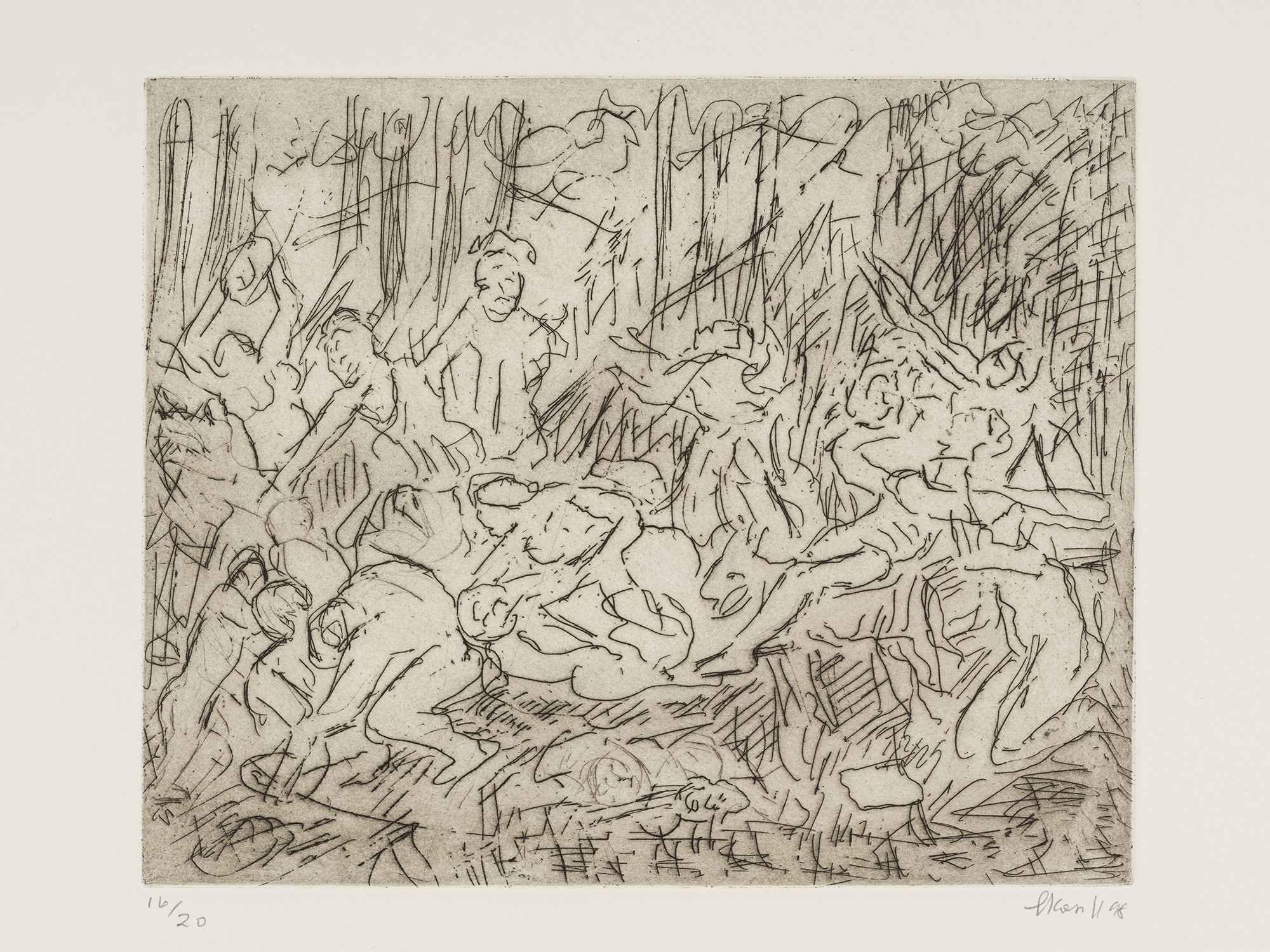
Leon Kossoff
The Triumph of Pan No. 1, 1998
etching, printed by Mark Balakjian
Plate: 7 7/8 x 9 5/8 in. (20 x 24.4 cm)
Paper: 22 1/2 x 29 7/8 in. (57.2 x 75.9 cm)
Edition of 20
Inquire
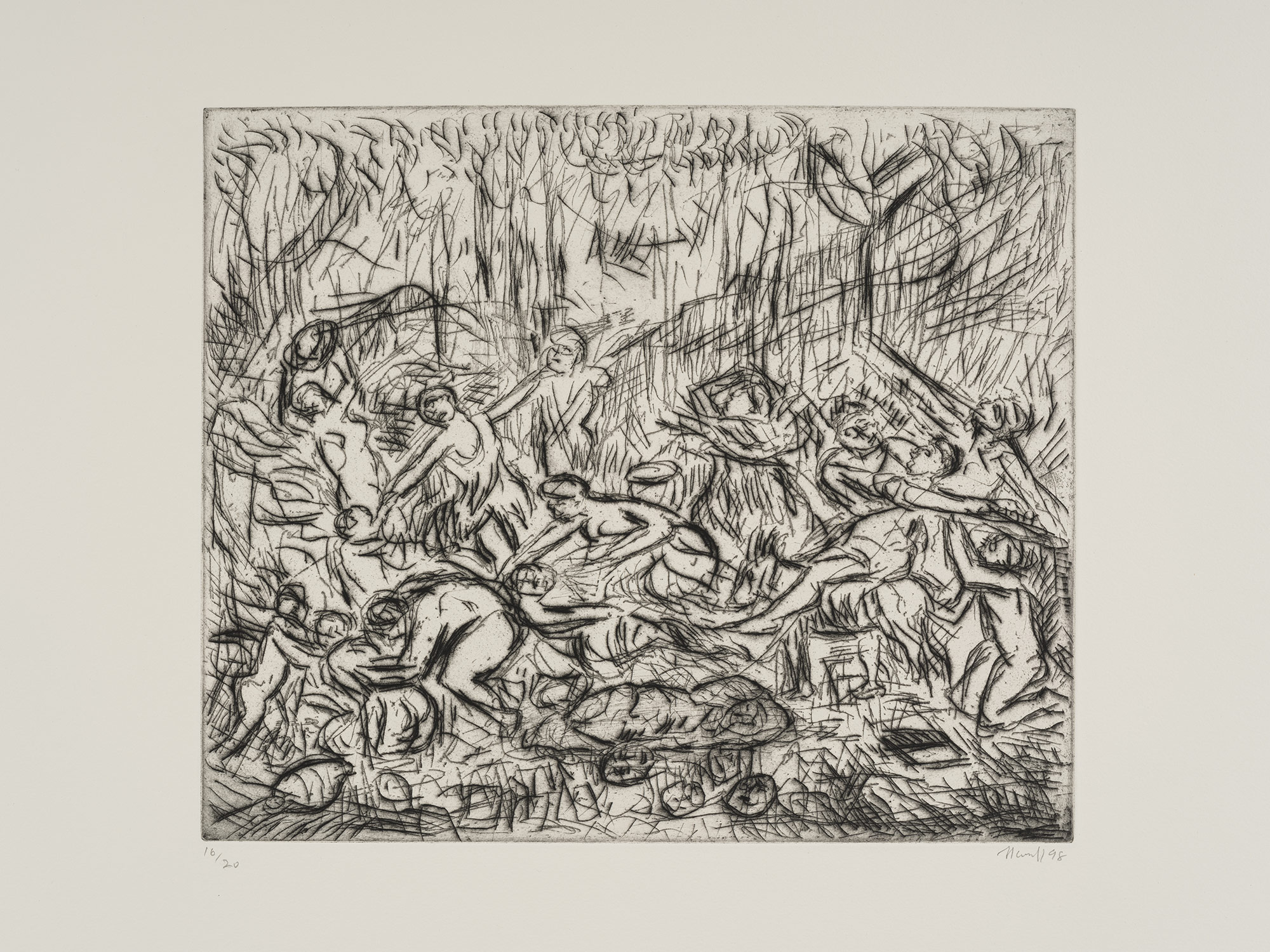
Leon Kossoff
The Triumph of Pan No. 2, 1998
etching, printed by Mark Balakjian
Plate: 13 x 15 7/16 in. (33 x 39.2 cm)
Paper: 22 3/8 x 29 7/8 in. (56.8 x 75.9 cm)
Edition of 20
Inquire

Leon Kossoff
The Triumph of Pan No. 3, 1998
etching, printed by Mark Balakjian
Plate: 17 15/16 x 21 1/2 in. (45.6 x 54.6 cm)
Paper: 22 7/16 x 29 7/8 in. (57 x 75.7 cm)
Edition of 20
Inquire
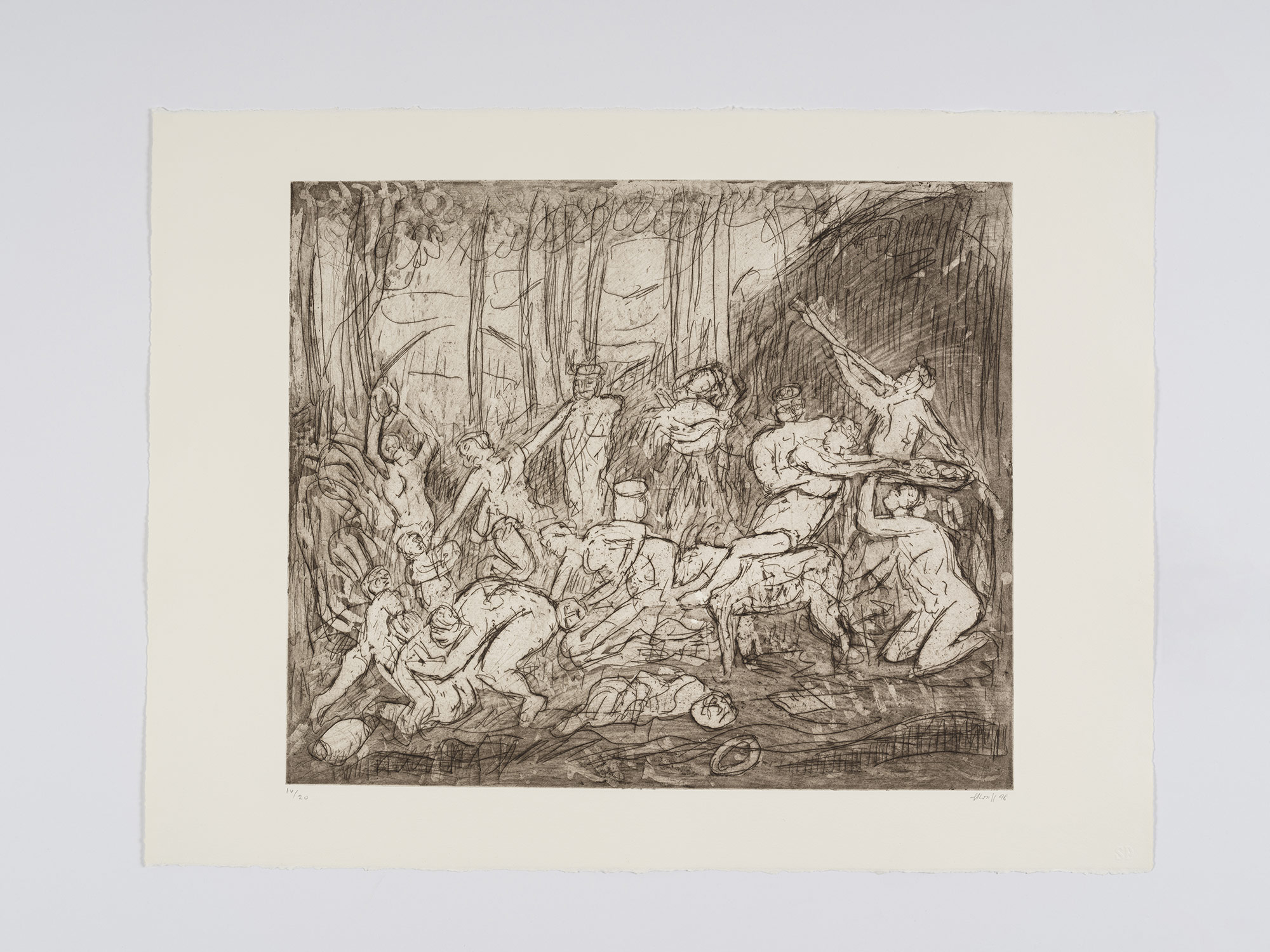
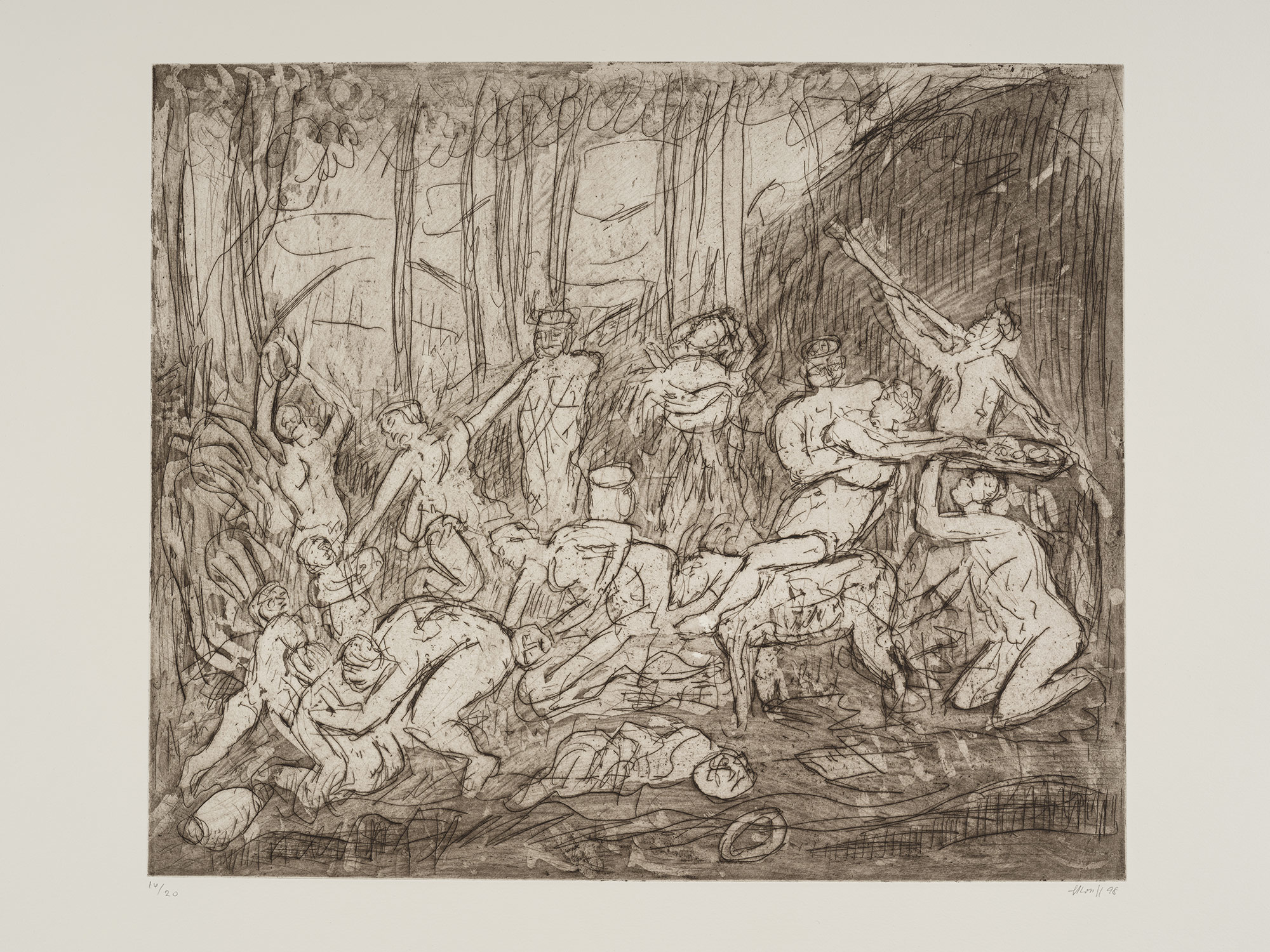
Leon Kossoff
The Triumph of Pan No. 4, 1998
etching, printed by Mark Balakjian
Plate: 17 15/16 x 21 1/2 in. (45.6 x 54.6 cm)
Paper: 22 1/2 x 29 7/8 in. (57.2 x 75.9 cm)
Edition of 20
Inquire
L.A. Louver will celebrate Kossoff’s work and our long relationship with the artist throughout 2021, leading up to the publication of a catalogue raisonné of his paintings in September and an exhibition in early 2022 in collaboration with Annely Juda Fine Art, London and Mitchell-Innes & Nash, New York.
Sales inquiries: sales@lalouver.com
Press inquiries: press@lalouver.com
310.822.4955 info@lalouver.com
Hours: Mon - Fri, 10 - 6 Summer hours: Mon - Fri, 10 - 6 Hours: Tuesday - Saturday, 10am - 6pm

